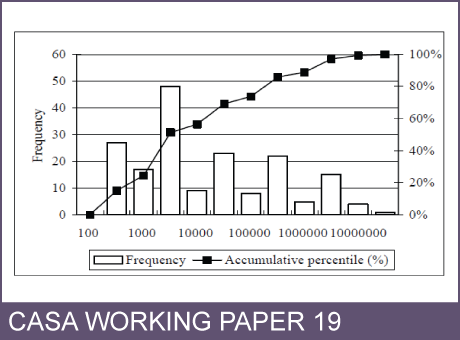CASA Working Paper 19

1 February 2000
Power Law Distributions in Real and Virtual Worlds
This study compares the statistical patterns of size and connectivity of the global domains (as in '.com' and '.uk') to the geographical distribution of the global population. As the development of Web sites represents the cutting edge of the new global economy, their sizes and contents are likely to reflect the distribution of population and the urban geography of the real world.
There is widespread evidence that population and other socio-economic activities at different scales are distributed according to the rank-size rule and that such scaling distributions are associated with systems that have matured or grown to a steady state where their growth rates do not depend upon scale. In this paper, we advance the hypothesis that the growth of Web pages in different domains is not yet stable. This is supported by our analysis that shows that the most mature domains with the most pages follow near rank-size relations but that countries which are much less advanced in their development and use of internet technologies show size relations which, although scaling, do not conform to rank-size. Our speculation is that as the Web develops, all domains will ultimately follow the same power laws as these technologies mature and adoption becomes more uniform. As yet we are unable to support our hypothesis with temporal data but the structure in the cross-sectional data we have collected, is consistent with a system which is rapidly changing and has not yet reached its steady state.
This working paper is available as a PDF. The file size is 153KB.
Authors: Michael Batty, Naru Shiode
Publication Date: 1/2/2000
 Close
Close

